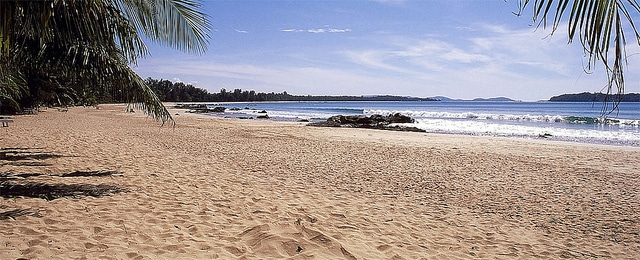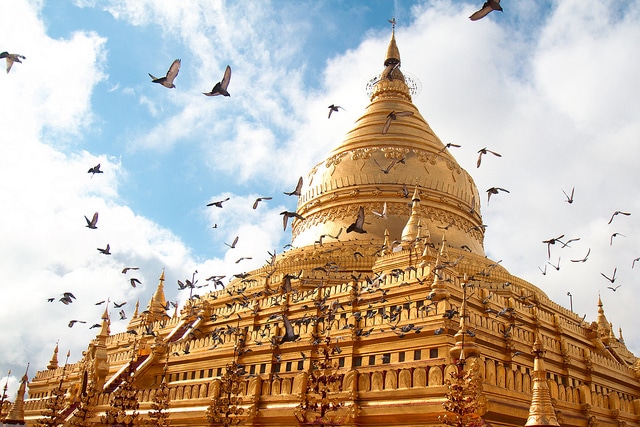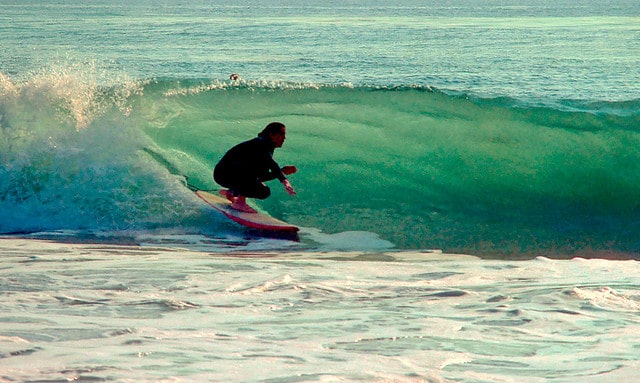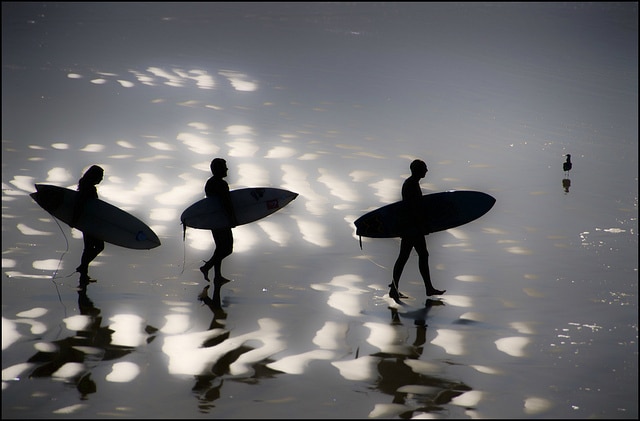
Undisturbed beaches nestled against warm, turquoise Andaman Sea set a majestic scene. Combine this with genuinely friendly and kind-hearted locals smiling their way into a newfound democracy — as well as highly affordable beachfront drinks and accommodation — and you have the epitome of a dream sea, sand and surf vacation. I’m talking about the Southeast Asian country of Myanmar, a pristine destination that’s somehow avoided many travelers’ radars, but should be added to your next trip itinerary.
Even the bravest travelers tend to overlook beautiful environments in the world if the geopolitical environment is the equivalent of a monsoon. For decades, this was the case for Myanmar. The country became known for workers’ rights violations and the 15-year imprisonment of Aung San Suu Kyi rather than its highly surfable swells and exotic Bagan temple ruins. Even the nation’s name became a controversy in 1989, when the military abandoned the title of “Burma” — a reference to the Burman ethnic spoken language — for “Myanmar,” which refers instead to the central region of the country. While it was deemed illegal to refer to the country as “Burma,” many citizens refused to abandon their heritage and fought the name change under the pretense that the government did not have the authority to perform an action of that nature.

Changes In Myanmar
Times are changing — albeit slowly — for the potential paradise nation. It took 11 years, but Free Burma activists were able to force western clothing manufacturers like Target, Wal-Mart and Levi to cease production in the nation – a lack of human rights regulations leading to these corporations creating factories with ghastly working conditions. After decades of military rule, the government caved to international threats of isolation and hosted elections. Former political prisoner and advocate for democracy, Aung San Suu Kyi even announced her plan to run for president in the upcoming 2015 election.
As the nation’s controversial haze clears, it reveals a breath-taking landscape and potential for economic stimulation through tourism. In 2012, over 1 million international travelers flocked to the Myanmar’s beaches and forests, opening a previously locked away nation. While the country is beginning to reveal its natural beauty to curious vagabonds, some are returning the favor by introducing the concept of surfing to the nation’s waves.

Surf Culture
Even ten years ago, if you were to travel to Myanmar for surf tourism, you would be met with curious stares and a lack of comprehension. Surfing in Myanmar only recently began making waves across the country’s shores, and the first surf pioneers in the country were left having to explain how a board is able to propel itself across waves without a motor to crowds of confused Burmese villages. Despite an initial lack of understanding, locals eventually comprehended and became drawn into a culture on an endless expedition for the next big wave.
The nation gets consistent surf swells from both Antarctica and the Indian Ocean from mid May to late September; however, these reliable waves also bring a pretty steady supply of rain, since it happens during monsoon season. The best time to venture out is either the beginning or end of the season, where you can catch the waves without the rain.
Even with the downpours, swells are enough of a ride to draw the attention of international surf company, Quicksilver. After a rigorous site selection process, the brand recently opened a shop in May of 2013, in the capital city of Ragoon. Sales have been positive, with locals and foreigners alike flocking to embrace the surf culture, and Quicksilver already looking to expand to a second Myanmar location. In addition to building the surf culture, the shop also held a skating demo for its opening event, introducing the country to this previously unknown sport.

Surfing Toward Harmony
Surfing and surf tourism aren’t only a means of earning money. They provide a much-needed balance to the country. When you’re in the ocean riding a wave, you’re not going to be discriminated based on your past or political views. In the water where you’re from and where you’re going is irrelevant. All that matters is getting on your board and enjoying the wave. Language barriers quickly fade to grey, and are replaced with crystalline waters drawing people out to sea and back to shore in harmony.
In a nation that has so much potential to offer, surfing and tourism can be ways to showcase what the area has to offer. That’s not to say this isn’t without risks like leakage and corruption. Far too many stories exist like that of Hainan island, dubbed “The Hawaii of China,” and left as an abandoned, overdeveloped and wasted land a few short years later. Some fear the same might become the fate of Myanmar; however, if tourists are conscious of the hotels they stay at and the business they frequent, it’s possible to support the country in a sustainable way.
Bonus Myanmar Travel Resources
Trekking Kalaw To Inle Lake: A Beautiful & Culturally Immersive Adventure
The Plight Of Burmese Women Refugees (And How You Can Help)
Myanmar Travel: Local Finds In Urban Yangon
14 Best Spiritual Yoga Retreats To Strengthen Your Body, Mind & Soul
About The Author
Currently working in a museum, Judi Zienchuk has lived everywhere from Southeast Asia to Northwestern Canada. She loves travel, longboarding and coffee flavored ice cream. To get more personal, check out her blog, Travvel Sized.
Latest posts by Judi Zienchuk (see all)
- 5 Common Travel Practices That Are Detrimental For The Environment (And How You Can Easily Change Them) - Oct 7, 2017
- Gingerbread: History, Traditions And Where To See The World’s Sweetest Artwork - Dec 4, 2015
- The Dark Side Of Easter: Child Slave Labor And How To Source Ethical Chocolate This Holiday - Mar 16, 2015
- Tips For Giving Your Trip A Responsible Makeover - Mar 6, 2015
- Going Local In Sumatra, Indonesia - Oct 21, 2014






There is no surf culture in Myanmar. I have been living here for one year and you cannot even rent a board in Chaungta or Ngwe Saung. Nobody there even knows what a surfboard is. The Quick store is all about fashion and skating. No idea what made you write this article.
Come up with surfspots, addresses of shops and rental stores, but you can’t because it doesn’t exist, so don’t spread false information on the net.
The surf culture of Myanmar is definitely no where near the size of the culture in nearby countries. However, unknown sites along the nation’s west coast like Gottaung Beach and Ngwe Saung have the potential to expand to become popular surf destinations as the country continues to open itself to international tourism.
There is good surf at the northern end of Ngapali beach during the cyclone season late November, December, January and February. The swell comes from Cyclones moving up the Bay of Bengal from the south and traveling north to the Bangladesh coast. I’ve been there and have enjoyed beautiful waves along the beach with a rock reef jetty just to the north bringing in good right hand waves. It is especially good when the cyclones hug the coast of India to the west as they travel up the bay. Unfortunately, the cyclones produce major devastation when they finally reach Bangladesh.
Judi is right. It doesn’t take an oceanographer to see that Myanmar has epic potential for developing a surf culture… just check the coastline on Google Earth. Unfortunately, my friend (whose hometown has some of this epic surf coast) tells me that his region is not safe for foreigners at the moment, but he is hopeful that this will improve in the next five years. By the way, this friend of mine is from Myanmar and runs a surf shop in Phuket. I would much rather go to Myanmar to surf (given the coastline that I see and his report) than Phuket to surf. Bali is too dangerous for me (I’m a longboarder)… and I like the Myanmar people – super nice! Hope they deal with the fighting so I can come enjoy.
Hey Stephen! I’ve just come across this, its been 4yrs+ since this comment! any updates on myanmar surf scene? 😉
Hello Judi,
Do you know if there are any surf schools in Myanmar?
Cheers,
A
I don’t know of any surf schools currently in Myanmar, however if the surf culture there continues to expand, I’m sure there will be some opening up soon.
Thx for your answer Judi
🙂
Do you know where I can get the information maybe?
Are there any decent waves around the Dec period? or does it flatten out completely?
@Damon: Not 100% sure. I would recommend contacting the local tourism board. They usually have the most up-to-date information on this kind of stuff. Best of luck!
Hi Judy,
My partner and I are headed to Ngpali beach in a few days. Are you aware of any places one can rent surf boards in the area?
Thanks!
@Natalie: Unfortunately Judi — who wrote the post — has taken a hiatus from writing for a bit and I myself don’t know the answer the that question. Sorry we couldn’t be of more help :/
Hello, any new development/updates since this article was written? Are there available waves in December and a place to rent a board or bring my own?
Thanks in advance to the intrepid travelers and explorers!
@Philip: Unfortunately at this point not too sure of any updates. Sorry!
Hi, it’s a place in Ngwe Saung now where you can rent boards.
Hiya,
We are planning a surf trip to Myanmar for a year in May (currently in Costa Rica and need to plan another so we don’t get the blues)! – am I right in thinking Ngwe Saun would be the best place to be based for consistent waves? – and a safe destination for tourists?
Thanks in advance!!!! Xx